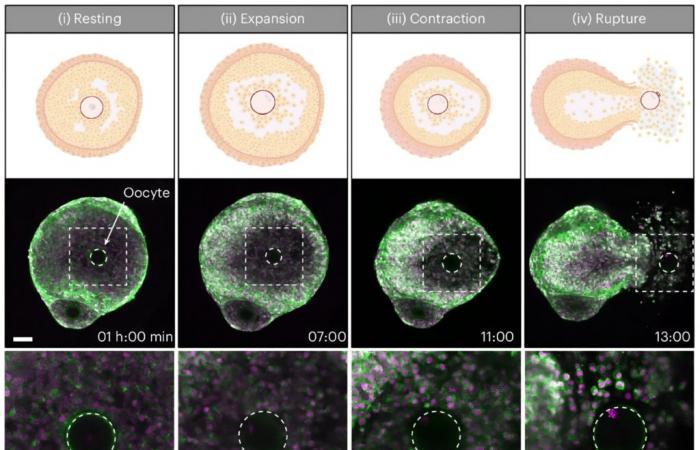Ovulation is a fundamental process for reproduction, but it remains little understood. A major breakthrough comes from a team of researchers who have, for the first time, filmed this entire phenomenon in mice, revealing its stages with unprecedented precision.
This detailed observation could well transform our understanding of reproductive mechanisms and fertility.
Ovulation, which occurs when the egg leaves a follicle in the ovary, has always been complicated to observe. Until now, researchers could only study this process from samples, often after the tissues had been fixed. However, a team from the Max Planck Institute has taken a decisive step forward by capturing these dynamics in real time, using mouse models and imaging techniques. microscopy advanced. The study is based on a series of technological innovations, including high-resolution microscopy coupled with a follicle culture system. The latter were isolated in the laboratory and encouraged to ovulate under the effect of specific hormonal treatments. This careful monitoring made it possible to capture the expulsion of the egg through detailed videos.
Research has highlighted the three key stages of ovulation. First, a mature follicle swells in response to the secretion ofhyaluronic acidwhich attracts the liquid towards the interior of the follicle. Then, muscle cells contract rapidly, expelling the egg.
Another important discovery concerns hyaluronic acid, a molecule essential for the proper functioning of ovulation. The team demonstrated that without this substance, ovulation did not occur properly. The impact of this discovery could have implications for infertility treatments.
In this video, cell membranes appear green thanks to a fluorescent protein, while chromosomes are distinguished by a magenta hue. In the center of the left image, we can clearly see the single-celled egg cell. The image on the right, meanwhile, offers a close-up where we observe the DNA of the egg cell stirring during meiosis, preparing for its decisive moment.
The researchers also observed the egg itself, its movement and internal cellular changes. Fluorescent proteins made it possible to visualize chromosomes and cell membranes, revealing previously invisible movements. This level of detail paves the way for a better understanding of ovulation abnormalities, such as in the case of polycystic ovarian syndrome (PCOS).
The practical applications of this research are promising. The ability to observe ovulation in its entirety could help diagnose and treat fertility disorders more effectively. It could also offer new insights for female infertility, including identifying early abnormalities.
Indeed, the results of this study, published in the journal Nature Cell Biologyopen the way to new explorations. Understanding precisely the mechanisms that govern ovulation could help develop better strategies to improve fertility and treat reproductive disorders.
With this advance, researchers hope to be able to study more closely the effects of various pathologies, such as PCOS, on ovulation. The potential to improve fertility treatments, through direct observations, could be realized quickly.
A green fluorescent protein was used to track and reconstruct the surface of an oocyte in three dimensions. This technique highlights its deformations and undulations, showing how it moves from the center of the follicle, approximately an hour before crossing the rupture site in a final burst of 10 to 20 minutes.
The ovulation process, until now shrouded in mystery, is thus becoming more transparent, offering new keys for the future of reproductive sciences.






